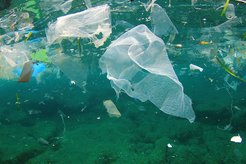The curse of durability
Can microorganisms help combat the vast amounts of plastic being disposed of in the sea?
Plastic is an indispensable part of everyday life. Bottles, bags, packaging and technical molded parts made of plastic are lightweight and resistant to water and decay. While such qualities are highly valued during usage, it is a different story when it comes to depositing plastic refuse in the environment. Here, the blessing of durability becomes the curse of imperishability.
By Friedrich Widdel

At first glance the problem simply appears to be one of an aesthetic nature. Because as ugly and dirty yet colorful heaps of plastic may be, plastic itself is non-toxic. The graver aspects of our plastic world only become apparent upon closer inspection – aquatic species that perish in nooses made of plastic waste or fish that ingest the tiniest plastic fragments, which could then be fed back into the human food chain. Evidence suggests, for example, that plastic softening agents could have a harmful long-term effect on fertility. And the impact of plastic refuse on an organism when it decays into tiny particles has yet to be established.
Whereas microorganisms, such as bacteria and fungi, are sometimes used to break down toxic substances in the environment, such as petroleum, plastic refuse has yet to be successfully disposed of. All decay-inducing organisms reach their limits with plastic; otherwise the material would not be so durable.
This is easily explained from a chemical perspective. All plastic materials are polymers, chemically-speaking. Polymers consist of very long chains of molecular units which in turn consist of carbon as the defining element. This is almost always combined with hydrogen. Other elements include nitrogen and oxygen and in exceptional cases also fluorine and chlorine. The long molecular chains ensure the polymers are strong and durable and do not decompose in water. Polymers can also be extremely flexible and pliable, a valuable property not provided by mineral materials, such as clay and limestone, and only to a limited extent by metals.
Polymers are not a human invention. Wherever robustness and shape retention but also toughness and flexibility are found in living organisms, this is down to natural polymers. Cellulose, a fibrous material made of sugar components, provides plants with their stability. Collagens and keratin are highly stable proteins – in other words, chains of amino acids – that give the skin or hair and bird feathers their stability.
Perishable and non-perishable polymers
However, neither cellulose nor keratin last forever. Outside of the living organism or after its death, these polymers are slowly decomposed by bacteria and fungi, i.e. their components are broken down, digested and ultimately oxidized into carbon dioxide and water. A principle known as microbial infallibility becomes evident during this natural recycling process. For every substance formed by living organisms, there is at least one type of microorganism in nature which can break it down.
However, plastics are not broken down in nature. Their chemical structure is foreign to nature and the principle of microbial infallibility does not apply here. “Chemically synthesized” should not though be equated with “non-degradable”. Several synthetic chemicals, such as detergents from washing-up liquid or insecticides, can clearly be broken down by microorganisms albeit slowly.
Degradability, despite being “foreign” to nature, is often explained by the fact that the chemical structure of artificial substances is similar to that of natural ones and is therefore attacked by degrading enzymes that have existed for a long time or have adapted through random mutation. So far there has been no indication of such degrading enzymes working on plastics. The enormous length of the chains probably presents a problem. If, for example, the polyethylene chain was significantly shortened, a petroleum hydrocarbon would be produced, an alkane which could easily be decomposed by oil-eating bacteria.
The ideal plastic material – one which remains durable during usage but decomposes after disposal – remains a utopic dream. Biodegradable plastic does exist though – these are polymers made up of microorganisms or polymers produced synthetically but which contain natural substances as components, such as polylactic acids.
Polyhydroxyalkanoic acids are polymers made of microbes. They act as stored nutrients for microorganisms in times of food shortages and lie in the bacterial cells as compact little balls. These stored foods often possess very favorable technical properties. They are ideal for transparencies, bags and bottles. However, they are more expensive than purely synthetic plastics and cannot be used where resilience to decomposition is required.
What next for plastic?
The best way to dispose of plastic is still complete combustion at the moment. The energy value of most plastics is as high as that of oil and it therefore produces significant amounts of useful heat. If the plastic material only consists of carbon, hydrogen and oxygen, only carbon-dioxide and water vapor are produced. The complete combustion of nitrogen-containing plastics would probably not present a problem either because only nitrogen gas would be generated in addition.
Surplus atmospheric oxygen and high temperatures are required to ensure effective controlling of the combustion process. However, if there is not enough oxygen and the temperature is too low, the plastic cokes into black carbon and other hazardous products.
Plastics containing fluorine (polytetrafluorethylene, PTFE, the brand name “Teflon”) and chlorine (polyvinylchloride, PVC) are difficult to dispose of. They do not burn on their own or burn poorly, but produce fluorine or chlorine compounds in heat in the presence of burnable substances and can even emit chlorine gas. Special procedures are required here during which the products must be further transformed or bonded.
The simplest and most cost-effective way of stemming the flow of refuse into the oceans is obvious – restrict consumption and increase the recycling rate. Plastic which is not disposed of in the environment in the first place does not have to be laboriously broken down or collected later.












